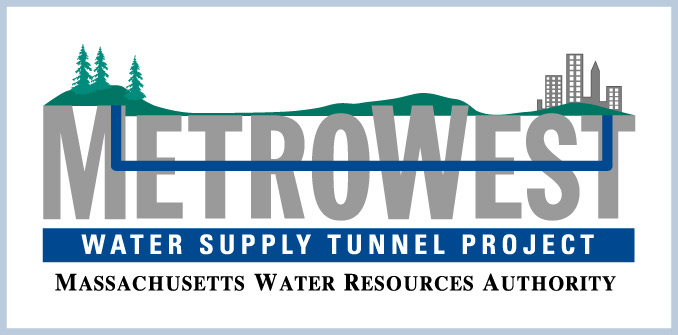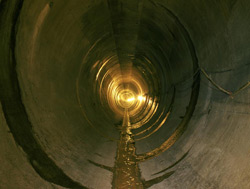The new tunnel greatly enhances the security, capacity and reliability of MWRA's entire water transmission system.
Until now, MWRA has relied on a single 1940's-era surface aqueduct, the Hultman Aqueduct, to serve all of Metro Boston. With its leaks and aging valves, the Hultman needed to be taken off-line for major repairs.
Before the MetroWest Tunnel, failure of the Hultman could have caused nearly complete interruption of Boston's water supply. This would have been a disaster for the region's public health, safety and economy.
MetroWest Water Supply Tunnel Quick Facts |
| Purpose: |
To enhance the security, capacity and reliability of the water system that serves 2.3 million people in 40 communities |
| Total Program Budget Set in 1995: |
$728 million |
| Total Program Estimated Completion Costs: |
$665 million (includes design, construction management, construction
and other support costs) |
| Awarded construction: |
8 contracts valued at over $506 million in construction costs |
| Length of tunnel: |
17.6 miles – roughly the distance from Rte. 495 to Rte 128, parallel to the Mass.Turnpike |
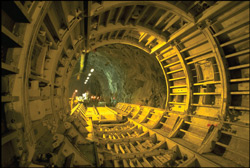
Installing forms for concrete lining 2001-2002
|
Diameter: |
Mined at 16 feet, finished at 14 feet |
Depth: |
200-500 feet deep |
Years to Complete each phase of construction: |
Excavating Shafts: 1 year
Mining: 2 years
Lining: 2 years
Line Shafts: 1 year
Piping, connections and disinfection: 1 year |
| Construction schedule and duration: |
Construction work took place over a 7-year period with over 6 million man-hours worked. Work proceeded 24 hours per day on 3 shifts, 5-6 days per week with no fatalities. |
| Mining: |
3 machines, each valued at over $7 million, were used to mine the tunnel
3 major working shafts: (Southborough,
Framingham and Weston)
9 connections to water facilities and communities |
| Under five communities: |
Marlborough, Southborough, Framingham,
Wayland, and Weston
Wye intersection 235 feet below the Mass. Turnpike tolls at Rte. 128 |
| Average production rate: |
57.1 feet per day
|
| Total rock excavated: |
1, 025,000 cubic yards |
| Kinds of Rock Excavated: |
Granite, gneiss, shist, quartzite and others |
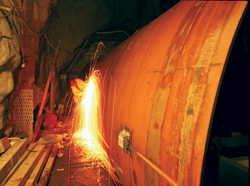
Workers inside the tunnel
|
| Total Amount of Concrete Used for Lining: |
184,722 cubic yards |
| Concrete Production Rate: |
154 cubic yards per day |
| Average production for lining: |
77 lineal feet per day |
| Project coordinated with: |
Treatment Facilities at Walnut
Hill (Marlborough) and Covered
Storage at Norumbega |
Reservoir (Weston)
capacity: |
450 million gallons per day |
| Amount of water needed to fill the tunnels and shafts: |
105.5 million gallons |
| Disinfected with: |
42,000 gallons of sodium
hypochlorite (chlorine) |
| Total Number of People Who Worked on the Project: |
1,907 |
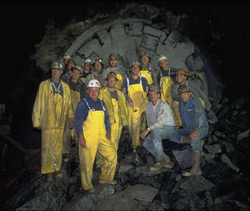
Tunnel workers, a.k.a. "Sandhogs" pose in front
of their Tunnel Boring Machine after holethrough
|
| Maximum Number of People Working at One Time: |
598 |
| Unions on the Job: |
Tunnel Workers Local 88, Operators Local 4, Electricians Locals 103 and 96 |
| Schedule: |
Broke Ground late 1996
Finished construction on schedule in Spring 2003
Final Testing and Disinfection in Summer/early Fall 2003 |
| Memorandums of Agreement with Communities: |
Weston
Wayland
Framingham
Southborough |
| Designers: |
Sverdrup/Jacobs Civil Inc. |
| Construction Management Team: |
Stone and Webster Massachusetts Inc., a Shaw Group Co.
Parsons Brinckerhoff Construction Services Inc.
Regina Villa Associates
Hager GeoScience
H2O Engineering Consulting Assoc.
DMC Engineering
Judith Nitsch Engineering
Revet Environmental |
| Major Contractors: |
Shea/Traylor/Healy
Modern Continental/Obayashi
Barletta Heavy Division |
